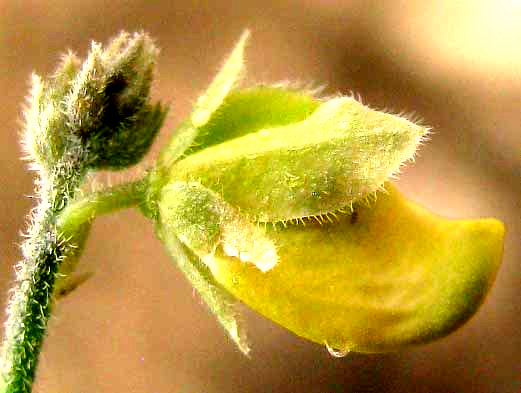Excerpts from Jim Conrad's
Naturalist Newsletter

from the December 8, 2013 Newsletter issued from the Frio Canyon Nature Education Center in the valley of the Dry Frio River in northern Uvalde County, southwestern Texas, on the southern border of the Edwards Plateau; elevation ~1750m (~5750 ft); N29.62°, W99.86°; USA
EGGLEAF MILKWORT
After such a long drought and a solid freeze, this week I wondered if there'd be any new wildflowers to identify. However, it seems that there's always something different if you just look hard enough and long enough, and in different places. Thus, sprouting from a clump of soil suspended over empty air where an arroyo's rushing water had washed away the bank below it, there was a delicate, finger-high plant with dark green, leathery leaves and pale green, wafer-like fruits that seemed too large for such a small plant. You can see the whole thing above.
The wafer-like fruits instantly brought to mind certain one-seeded legumes found among certain members of the Bean Family, such as lespedeza, but leaves in that family mostly are compound and have stipules at their bases, unlike this plant's. The fruits could almost be elm samaras, but elms are trees. On and on I went disqualifying one family after another until it seemed that I was stumped. But before surrendering I looked around in the hopes of finding a plant still bearing some flowers, and there was. Below, you can see its tiny, yellow blossom:

Another plant bore flowers which when I touched fell off. A shed blossom better showing the flower's structure appears below:

Could this be anything but a blossom of the Bean Family? Notice how it appears that the two large lower petals fuse along their common sides to form a scoop-like "keel" occupied at the bottom by stamens with long, curved filaments -- exactly as with most "papilionaceous" flowers of the Bean Family. But, could any Bean Family member produce such simple leaves with no stipules? Also, the flower in the last picture is missing the top petal. And if the stamens are counted, only eight are found, instead of the ten more common for similar flowers in the Bean Family.
Eventually, with a great deal of mind searching and general blundering about on the Internet, it became apparent that our little plant was a member of the small Milkwort Family. On most web pages and in fieldguides it's listed as POLYGALA OVATIFOLIA, but recently it's been shifted to another genus and is known as Hebecarpa ovatifolia. In English it's often known as the Eggleaf Milkwort. On the phylogenetic Tree of Life, the small Milkwort Family stands immediately beside the Bean Family. I'd known this, but the milkwort species I've seen were herbs with tiny flowers in slender, spike-like racemes. I just hadn't known that a Polygala flower could look so much like a bean flower.
Eggleaf Milkwort is endemic to just a dozen or so counties in southwestern Texas and across the river in arid northeastern Mexico. This is a good find, a plant seldom documented in the literature.